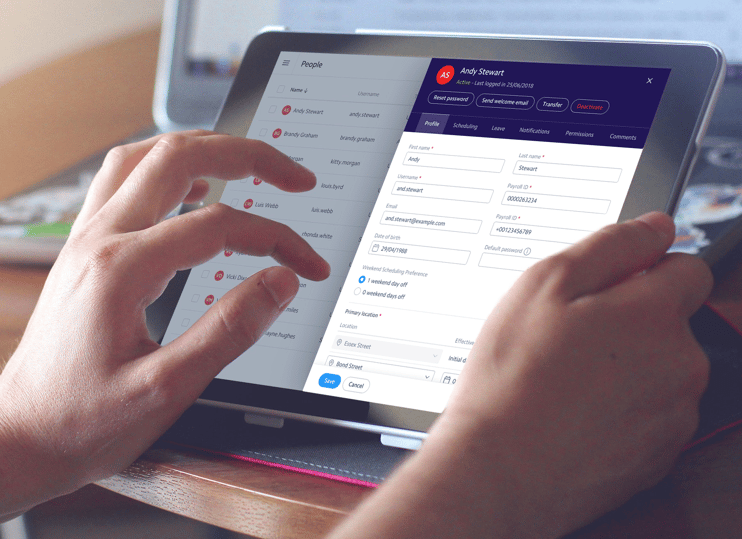Catering to employee preferences through automatic scheduling
by Rotageek on 11 November 2020

As the UK’s leading provider of automatic scheduling software, we are often tackled with the challenge of delivering a solution that caters for all walks of life. In this blog, Rotageek’s Head of Data Science, Dan Chamberlain, discusses how innovations in technology can cater to self rostering, generating a fairer, more optimised set of rules than human schedulers.
TL;DR? You can now listen to the blog post ⬇️ here:
How automatic scheduling caters to employee preferences
People are different, and so are their values
When it comes to scheduling, one of the most challenging decisions we face as a provider of rota creation software to large scale companies, is defining a common set of principles for measuring fairness. Distributing workload, unattractive shifts and overtime is a tricky consideration - especially when it needs to be balanced for hundreds, if not thousands, of employees.
Before rolling out a centralised rostering system, most businesses leave fairness considerations up to individual store managers, leading to a patchwork of inconsistent or conflicting rules. This can result in cross-departmental jealousy and accusations of unfair treatment among many other widespread concerns.
Companies adopt generalised rules to ensure ‘fairness’, but this concept only exists to the human schedulers
Historically, we have helped businesses address this major problem by guiding a discussion between managers and head office teams to discover a single set of fairness rules that should be enforced across the business. Yet this transition process remains difficult - a new set of rules can often conflict with the scheduling expectations of both the managers and their workers.
The issue still remains in that a common set of fairness rules allow no room for what employees independently want from their schedules. This is true even when rules are unique at each location, as managers still apply broad-brush rules to make scheduling a simpler, more manageable task.
There is a prominent need to recognise that each team member is unique, with different preferences and constraints regarding when and how they wish to work. By providing employees with the tools to voice these preferences, we grant increased autonomy and control over their schedules; consequently leading to reduced sickness absence, overall higher productivity rates and improved retention.
Machines can do much better
At the same time, giving employees this ability to customise their schedules can make optimal rota creation attainable even though we have dramatically increased the complexity of the scheduling puzzle.
Stores that apply the same fairness rules to all colleagues make it hard to find staff for particular types of shifts. Take a store that guarantees one day off each weekend to each staff member. If a weekend has unusually high customer footfall at any given point, it would be difficult to obey this fairness rule and adequately staff the store.
Trying to satisfy employee-specific preferences is a difficult task for a human rota maker. There are simply too many moving pieces to make sure you can adequately staff your store and give your colleagues autonomy over their schedules. Luckily, schedule optimisation tools, like Rotageek's Autoscheduler, are able to deliver rotas in line with diverse constraints while still optimising the fit to customer demand.
Automatic scheduling is a flexible working solution
At Rotageek, we’ve built new features into our product that allow us to capture and schedule to employee preferences. To use these new solutions, we simply need two pieces of information: candidate rules and individual requirements.
There are an infinite number of ways that businesses can allow workers to restrict their schedules. To make this feature work, businesses need to identify two or more rules that an employee must choose between. Before employees can specify a preference, we need to know to which rule they should default.

Employees then have the opportunity to select one of the alternative rules instead. This is a dynamic setting which can be changed between schedule runs as each employee's individual circumstances change. When the Autoscheduler is launched, the currently selected rule for each team member will be enforced.
Defining two fairness rules; a test of efficiency
To illustrate, we generated scheduling input for some of our current clients. For each client, we replaced their current fairness rules with two potential employee preferences:
- One guaranteed weekend day off
- No weekend days off
These rules were chosen as they represent possible competing preferences by different types of workers. Many individuals may have childcare, education, or other employment constraints during the week and prefer to focus their work on weekends. Other employees without these considerations would prefer to have at least one weekend day off each week.
We then launched a series of tests, randomly assigning employees at each location to one of the two preference rules. In each test, we varied the percentage of the population assigned to each rule. The effect on demand is shown below.
The plot shows staffing error against the percentage of employees who selected each of the fairness analysers. The staffing error penalises both over and understaffing, giving only perfectly matched demand a score of zero.
When all workers were required to work on weekends, 25% of staffing hours in the week were staffed incorrectly. This was reduced to 23% when all workers were given at least one weekend day off.
However, even a small amount of diversity amongst employee preferences is better than either extreme. At the most optimal point, match to demand improves by 4% and those hours will either contribute to improved customer service or could be realised as cost savings. It is therefore conclusive that providing an option for flexibility can benefit employees and improve the ability to staff to demand.

Flexibility in scheduling is an employee engagement strategy as well as a business benefit
Employees do and always will have diverse preferences, so giving them increased autonomy and control over their schedules is a long-term driver for engagement and overall happiness. Capturing this diversity can also improve business outcomes. Employees with varying constraints can be more flexibly staffed to demand that varies throughout the day and week. However, the problem quickly becomes too complicated for a manager to solve and so most of the benefits can only be realised by using a scheduling algorithm like Rotageek’s Autoscheduler.
Get in touch today to discuss how your business can be optimised with the use of Rotageek data-driven technology.
- Quick links
- Log In
- Book a Demo
- Help Centre
- Products
- Digital Scheduling
- Autoscheduling
- Forecasting
- Company
- Our Story
- Careers
- Blog
- Privacy Policy